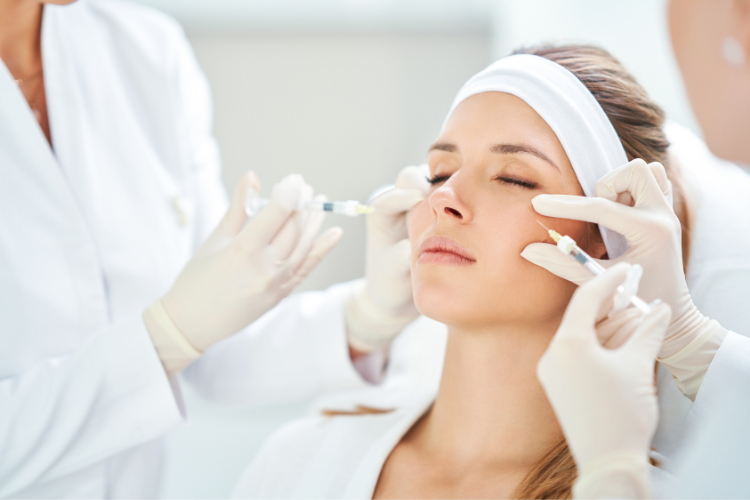Whether someone is meeting you for the first time or the hundredth time, your smile and teeth are among the first things they will notice about you. You appear more attractive and feel more confident when you have a gorgeous smile and healthy-looking teeth.
Most of us don’t have naturally beautiful grins. But fortunately, Inglewood Dental provides a variety of choices to address faults and imperfections so you can have the smile you’ve always wanted. In order to help you get rid of creases and wrinkles around your mouth and give you a radiant smile that looks more youthful and less stressed, we provide BOTOX treatments using the latest cutting-edge methods.
Botox for Cosmetic Dentistry
Botox can help with the balance and wrinkles around the mouth, giving your smile a younger, fuller appearance. Botox might help you balance your grin if one side is higher than the other due to a condition.
If you have a so-called gummy smile, Botox is routinely employed. As a result, when you grin, a significant portion of your upper gum is visible. Your upper lip can be prevented from over-contracting by receiving an injection of Botox. Because of this, your smile will cover your gums more easily.
Last but not least, black triangles can be filled with Botox. These are tiny, open spaces that have formed between the gums and the spaces in between the teeth. These teeny, difficult-to-keep-clean spaces are unsightly and a threat to dental health since food particles have easy access to them. Botox Calgary is a promising solution for one of the most challenging conditions to treat. To assist in filling those tiny crevices, it is injected into a specific area of the gums.
Botox for TMJ Treatment:
Patients with TMJ issues may benefit from using Botox as well. It can be injected into the muscle to lessen tooth grinding and clenching. Allowing the mouth to relax into its normal position helps to alleviate many TMJ symptoms and prevents discomfort and tooth damage. It’s especially beneficial for people who clench their teeth firmly enough to break the typical oral appliances used for TMJ treatment.
Muscle Relaxation: The muscles surrounding the jaw joint can be made more relaxed by Botox injections. This can lessen the muscle tension and spasms that cause pain and discomfort in the TMJ. Botox works by temporarily numbing the muscles to reduce discomfort and enhance jaw function.
Discomfort Relief: Jaw, facial, and head discomfort are frequently caused by TMJ. By easing muscle tension and inhibiting muscle spasms that could increase the symptoms, Botox can help relieve this pain. For those with TMJ issues, it might provide momentary relief and enhance the quality of life.
Jaw Locking: Some TMJ conditions might result in jaw locking or limited jaw movement. Botox can help relax these muscles and increase jaw mobility by being injected into the jaw-moving muscles.
Dental Botox Procedure:
The main goal of the dental botox procedure is to change the muscles that cause wrinkles in the skin around the face. Before starting the operation, the skin is covered with a local anaesthetic lotion. Immediately after the treatment is finished, ice will be applied.
A tiny amount of Botox is injected into the wrinkled area of the face during the Botox procedure. Due to its ability to block nerve impulses, Botox aids in the relaxation of the facial muscles. As the facial muscles relax, the skin on the face starts to smooth. Up to six months could pass before the effects wear off. Therefore, after that time, patients might need to undergo the procedure once more.
Maintenance and Follow-up
Botox aftercare aims to promote the best possible treatment outcomes. Additionally, it can lessen the chance that the bruise will spread to other places. The process doesn’t take too long. It just takes a few minutes, after which the patient can resume their daily activities. If patients adhere to the instructions following the procedure, the length and intensity of recovery may be reduced.
These recommendations include refraining from applying cosmetics, indulging in strenuous exercise, and avoiding lying flat on your stomach for the first four hours following the treatment. Additionally, you must refrain from rubbing or massaging the treated area for 24 hours after the treatment.
On the day you have Botox, it’s typically a good idea to:
- Exercise your face gently
- Rest for the remainder of the day and keep your heart rate moderate.
- Avoid rubbing, touching, or applying pressure to the injured region.
- Keep the treated area unaffected.
We Have Reputable and Skilled Dentists
Dental botox can relieve your temporomandibular joint (TMS) problems’ pain and discomfort. Our dentists near you are skilled and experienced in treating and resolving dental issues. Any treatment plan they recommend for you will be specifically made for you. Call us if you have any questions about the process.


